Everyone knows that at high levels of competition, the slightest advantage can be the difference between chicken dinner and a sloppy second place sandwich. So competitive gamers should be really excited by the Asus PG259Q. This is the first 360 Hertz gaming monitor. But can this fast IPS panel even take advantage of that kind of high refresh rate without becoming a blurry mess? Can any PC games even run at 360 frames per second? And, if they can, will you, a common gamer, be able to properly appreciate the difference between this and an already insanely fast 240 Hertz monitor? I doubt it.
You've probably heard, or even experienced, that upgrading from a gaming monitor that refreshes at 60 Hertz up to one that refreshes at 100+ Hertz is a much more noticeable jump than say going from 120 or 144 up to 240.  That's because 60 Hertz displays are showing you a new frame about every 16 and a half milliseconds, whereas 120 to 144 Hertz, that's a new frame about every seven milliseconds. That means that whatever you're looking at in that comparison, is going to be twice as up to date. Then, when we jump from 144 to 240, that only shaves three more milliseconds off. And finally, going from 240 to 360, that's an extra 120 refreshes per second above the existing fastest monitors around, for a whopping savings of just 1.4 milliseconds, each frame. To find out if that's an improvement that can even be perceived by the average gamer, we set up a blind test with the PG259Q next to not one, but three competing 240 Hertz monitors to see if anyone, could tell the difference.
That's because 60 Hertz displays are showing you a new frame about every 16 and a half milliseconds, whereas 120 to 144 Hertz, that's a new frame about every seven milliseconds. That means that whatever you're looking at in that comparison, is going to be twice as up to date. Then, when we jump from 144 to 240, that only shaves three more milliseconds off. And finally, going from 240 to 360, that's an extra 120 refreshes per second above the existing fastest monitors around, for a whopping savings of just 1.4 milliseconds, each frame. To find out if that's an improvement that can even be perceived by the average gamer, we set up a blind test with the PG259Q next to not one, but three competing 240 Hertz monitors to see if anyone, could tell the difference.
There were quite a few learnable here, starting with that none of our gamers, even the ones who guessed correctly, were confidently able to identify the 360 Hertz monitor from gameplay. But, is it just because the refresh rate jump is too small? Another factor could be the pixel response times. Remember guys, if the pixels can't change color fast enough, smeary motion blur could hurt the experience, no matter how many times you refresh the picture per second.
Anyway, early 240 Hertz monitors, like the Asus PG258Q, used TN panels, the LCD technology with the fastest pixel response times. By contrast, the PG259Q uses an IPS type panel, which is traditionally known more for color accuracy and wide viewing angles, rather than for speed. So to see how the pixel response times of this new monitor compared to its 240 Hertz TN predecessor, we put together a Blur Busters Pursuit Camera setup, which helps us capture the motion blur produced by the monitor without the blur introduced by persistence of vision. You can see here, the old TN has less ghosting, but is actually a bit less clear with thicker lines and a bit of image doubling.
You can see here, the old TN has less ghosting, but is actually a bit less clear with thicker lines and a bit of image doubling.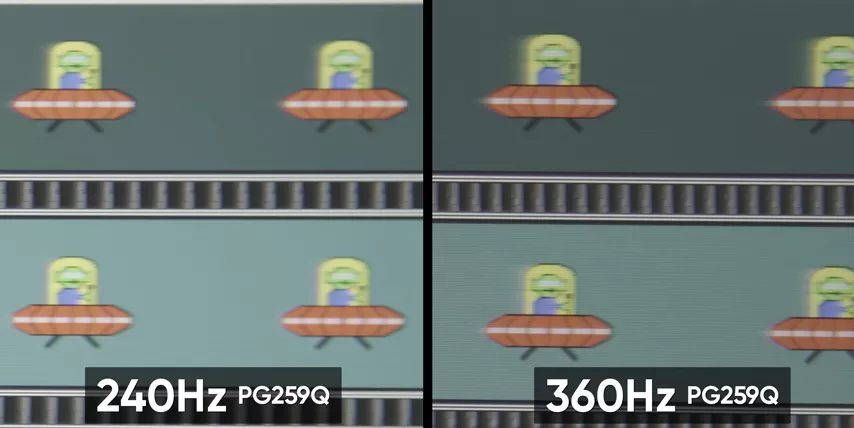 Compared to itself running it 240 Hertz, the PG259Q at 360 looks only slightly more clear, but with a similarly slight increase in inverse ghosting caused by pixel overdrive and a lot more smearing on the dark background, which suggests that the panels struggles with light to dark transitions. And for bonus points, by the way, here it is compared to the Samsung Odyssey G7, which uses a VA panel.
Compared to itself running it 240 Hertz, the PG259Q at 360 looks only slightly more clear, but with a similarly slight increase in inverse ghosting caused by pixel overdrive and a lot more smearing on the dark background, which suggests that the panels struggles with light to dark transitions. And for bonus points, by the way, here it is compared to the Samsung Odyssey G7, which uses a VA panel.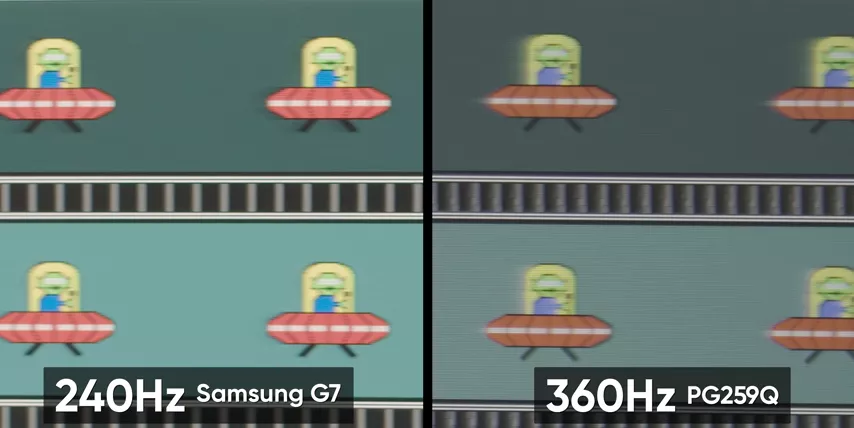 Interestingly, the clearest image we got from the PG259Q, was when it had ULMB turned on, which is only available at 144 Hertz and 240 Hertz. Nothing more, nothing less.
Interestingly, the clearest image we got from the PG259Q, was when it had ULMB turned on, which is only available at 144 Hertz and 240 Hertz. Nothing more, nothing less.
Anyway, with all that in mind, is there any point in paying, that's more expensive, two to $300 more for the PG259Q compared to a last gen 240 Hertz monitor? Well, probably. In our video investigating how refresh rate affects the performance of pro gamers, we discovered that it depends on the in-game scenario. So, even if this monitor doesn't offer much more motion clarity than existing offerings, the higher refresh rate could still give you an advantage in situations, like our CS: GO double-door hallway test, where having the most up-to-date information can make a huge difference. And, there are actually other ways that this monitor is just plain better than its predecessors.
Take a look at this color accuracy.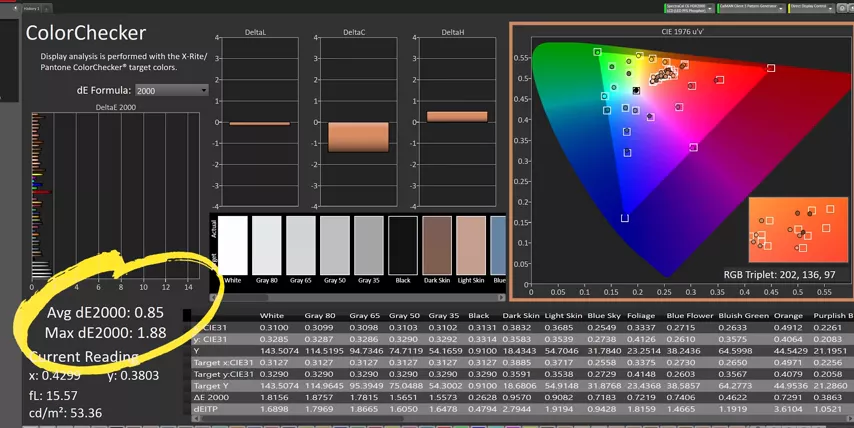 Yeah, that's for real. You could legitimately use this thing for gaming by night, and creative color critical work by day. As long as you're working in the sRGB color space. That's because as an eight-bit panel, it's gamut coverage isn't the greatest. And, unfortunately that doesn't change, even if you use a graphics card that supports display stream compression.
Yeah, that's for real. You could legitimately use this thing for gaming by night, and creative color critical work by day. As long as you're working in the sRGB color space. That's because as an eight-bit panel, it's gamut coverage isn't the greatest. And, unfortunately that doesn't change, even if you use a graphics card that supports display stream compression.
That also plays into its HDR performance. I mean hey, it's HDR 10 compatible. But, it's low peak brightness keeps it from really shining in this respect. 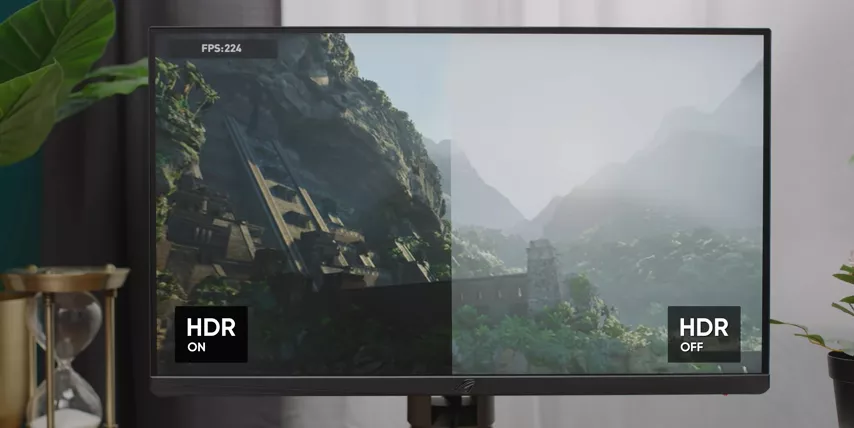 And like most HD-aren't monitors as we call them, it can look sometimes worse in HDR mode than in SDR. It also has G-SYNC though, and that is standard real G-SYNC, not compatible or ultimate, which means that it's variable refresh rate range is completely unlimited, and it means it has variable overdrive, meaning less noticeable coronas at lower frame rates than you would get if it was over-volting the pixels the same across all frame rates. It does have limitations. As mentioned earlier, it's got ULMB, but, notice the use of NVIDIA's acronym here. Asus usually calls their low-motion blur ELMB and, mightn't you expect it to have ELMB Sync, that is backlight-strobing wild G-SYNC is on? Well, sorry, it doesn't. You'll have to turn variable refresh rate off if you want that motion blur reduction that gave it that amazing clarity.
And like most HD-aren't monitors as we call them, it can look sometimes worse in HDR mode than in SDR. It also has G-SYNC though, and that is standard real G-SYNC, not compatible or ultimate, which means that it's variable refresh rate range is completely unlimited, and it means it has variable overdrive, meaning less noticeable coronas at lower frame rates than you would get if it was over-volting the pixels the same across all frame rates. It does have limitations. As mentioned earlier, it's got ULMB, but, notice the use of NVIDIA's acronym here. Asus usually calls their low-motion blur ELMB and, mightn't you expect it to have ELMB Sync, that is backlight-strobing wild G-SYNC is on? Well, sorry, it doesn't. You'll have to turn variable refresh rate off if you want that motion blur reduction that gave it that amazing clarity.
Should you buy this monitor? I, for one, think it's absolutely fantastic. But only for a very specific gamer. So if you're a competitive player and you play games that your PC can actually run at frame rates above 300 FPS, and you don't need more than 1080p, then this is one of, if not the best 240 Hertz monitor on the market. And, Oh, it can also run it 360 Hertz, if you're a sensitive and skilled enough to, well, if not benefit from it, at least even notice it.
Comments (1)